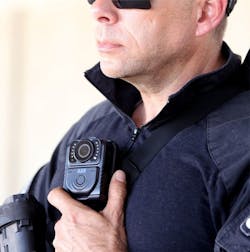Many cities are already deploying Body Worn Camera (BWC) systems to document and capture police officers’ interaction with citizens in order to reduce citizen complaints, false lawsuits, use-of-force and mistreatment of the civilians. Using these systems, almost all interactions and conversations between police officers and citizens will be recorded and could be used for evidentiary purposes. The anecdotal evidence thus far suggests that using body cams will reduce the number of complaints by the citizens, and will force both police officers and civilians to act in a more civil manner.
With the proliferation of mobile devices like smartphones and tablets that are capable of capturing video imagery, more and more people are using their devices to record police activity. That imagery is posted online for public consumption. Unfortunately, these images can be edited, and frequently tell only part of the story. It is hoped that BWCs will be an effective tool to tell a complete story. BWC advocates contend that they will protect police officers from false accusations and mistreatment of civilians, and will provide a fair and objective view of what really happened.
Throughout the United States, many cities are now planning to deploy BWC technology. However, there is uncertainty as to how best deploy and implement BWC, and integrate with existing law enforcement systems so as to best improve efficiency, service delivery, and sustainability. Police agencies must become familiar with the BWC deployment lifecycle, hidden costs, required storage specifications, best practices and Standard Operation Procedures (SOP). This is especially true with respect to the legal aspects of BWC implementations. Many agencies are seeking guidance from early adopters, and looking for feedback and lessons learned so that they can work on their deployment plan, allocate budget and define their Total Cost of Ownership-based road map plan.
As jurisdictions think through this process here are some considerations:
Financial: In early 2015, the U.S. Justice Department announced that they will provide $20 million in grants to local police departments to purchase 50,000 BWCs for law enforcement agencies. This grant funding was to be part of a $75 million body cameras funding program to be distributed over three years. The Justice Department will match funds dedicated by the Department to buy cameras and train police on how to use them. Unfortunately, this funding cannot be used to pay for storage of the video footage captured, which will often make up one of the largest costs of the program.
Not infrequently, vendors will offer cameras worn by police officers on uniforms or glasses at a fraction of a cost, contingent upon a department signing a multi-year data storage and management deal - that are far more profitable over the long run for product manufacturers. The camera manufacturers know that the cameras will be commoditized fairly quickly. Real profit for the manufacturer will come from subscription business model where data and video content are being managed. Data management and subscription fees are between $20 and $100 per officer per month, depending on the volume of video that is generated. Departments with around 100 BWC can easily pay over $300,000 with devices, storage, and resources in a couple of years. Each department’s data and video retention policies drive storage requirements, and can play a major role in a BWC budget.
Technical: Buying a body camera is just the tip of the iceberg. Agency CIOs must think through the various technical requirements of the BWC ecosystem. Those aspects include storage; required equipment, hardware and software support; subscription of the application services; maintenance; licensing; security; archiving; and disaster recovery just to name a few. Each of these technical elements has larger law enforcement implications. For instance, capturing and storing video data has a significant impact on an investigation, evidence management and chain of custody processes. Once the data is captured, video has to be tagged, indexed and should be ready for search and retrieval purposes. This process must ensure that data tampering and unauthorized editing and copying does not occur. Also, departments must be able to redact video images in a manner that’s quick, efficient and thorough to meet legal and public disclosure requirements.
Video storage, retention, and security are already a nightmare for many CIOs. Unfortunately, BWCs are only going to exacerbate that concern. BWC systems can produce massive amounts of video, as well as the metadata to track and manage the video clips for retention. Moreover, data that’s part of a criminal or civil legal proceeding may have to be kept for many years. Securing, storing and creating redundant data storage is a major technology issue and one those CIOs will need to address in the most cost-effective fashion.
Municipalities’ non-evidentiary video retention policy may vary from 15 days to 180 days (sometimes even longer) based on their operational needs or records retention ordinances and statutes. Additionally, Freedom of Information Act (FOIA) and Sunshine Statutes also impose requirements. These long-term storage requirements present an opportunity to leverage cloud storage services as part of a BWC system. Security and trust in cloud services have traditionally been a cause of discomfort among IT decision makers within public safety sector. Also, many cloud computing platforms – except for a handful of vendors – don’t meet the Criminal Justice Information Services (CJIS) requirements mandated by the FBI. Driven by the high cost of video storage, infrastructure and labor requirements, many police departments are reexamining the cloud’s unlimited scalable storage environment. A thoughtfully chosen cloud solution can allow departments to take advantage of cost savings, accessibility, usability and disaster recovery functionality while reducing their IT operational cost by 30 to 60 percent.
Legal: Privacy concerns are a major non-technical concern around BWC – from the law enforcement officers’ perspective as well as the people they interact with and therefore record on video. Use of BWCs in areas like residences where individuals traditionally have had an expectation of privacy is just one significant area of citizen privacy concerns. BWC use must be governed by standards that protect the reasonable expectations of privacy of those being recorded. Some supporters of BWCs say that all interactions between police officers and the public should be recorded regardless of the circumstances, while others argue that officers should use discretion in deciding where and when to record. As state requirements and local policies take shape, it will affect the technical side of the equation in terms of device usage and data volume and storage.
Public Safety: From an overall system integration perspective, BWC systems will align with other large technology initiatives like Next Generation 9-1-1 (NG911). The NG911 initiative states that legacy 9-1-1 systems (in the United States and Canada) need to be updated with advanced public emergency communications services to accommodate today’s exponentially increasing wireless mobile society. The enhanced technology aims to enable the public to phone in from mobile devices, and also transmit text, images, videos and data to the 9-1-1 center also known as a Public Safety Answering Point (PSAP). NG911 initiatives are a “must have” requirement, considering more than 70 percent of all 9-1-1 calls are now initiated from wireless phone lines.
Since BWC devices are capable of capturing voice and video – which is then tagged and searchable for incidents – 9-1-1 calls can also be tagged with the incident and stored as evidence management in line with chain of custody protocols. The result: each call-for-service will have metadata with rich content associated with it. Using the metadata, police departments would be able to utilize advanced search and analytical tools that include facial recognition and license-plate-recognition (LPR) to help narrow down the relevant video for incidents.
A BWC system can interface a number of other critical police information systems, stretching from Computer Aided Dispatch (CAD) and records management system (RMS) to content management system (CMS). However, evidence management is the one system that will experience the biggest impact from BWC systems.
BWC-captured video can be used to predict criminal activities and provide quality data for police departments to utilize and make solid decisions. Capturing the camera images alone, without processing associated metadata content, offers only limited information and insights. While GPS-enabled cameras can track the officers in the field, they cannot identify the scene and make intelligent recommendations regarding the scene. Using big data in conjunction with the BWC’s data, predictive policing can forecast potential criminal hotspots, gang activity and build a criminal history of an area.
Using predictive analytics’ sophisticated algorithms and software to analyze big data will help police departments and other public safety agencies monitor, measure, and predict criminal activities. Predictive analytic models do not magically tell you what is going to happen in the near future; however, using BWC and combining them with other related information, one can predict what might happen in the near future with a degree of a reliable outcome. This outcome can also include what-if scenarios, providing police operation centers and police officers with data-based guidance.
Recommendations
The diversity of features and functionalities that must be assessed when selecting a BWC system is daunting. Additionally, as BWC systems can be integrated with a suite of existing public safety systems, the complexity of selecting a BWC product is even greater. Designing the backend infrastructure, deploying and integrating BWC is certainly a complex mission for any police department regardless of size.
Conducting thorough needs analysis can guide police departments through the process with minimal risk and optimal results. Integrators with deep knowledge of public safety operations and working knowledge of public safety technologies can provide agencies with the skillset and deployment methodology needed to deliver a robust solution. The right system integrator will leverage existing technologies, create connectivity between existing and planned systems, and deliver productive insights to ensure maximum ROI and achieve intended benefits.
BWC systems need to integrate and interoperate with existing applications and platforms for an optimized outcome. For this very reason, BWC system projects must be included in the multidimensional integration architectures of IT departments. It is imperative to minimize the risk of creating agency-specific, stovepipe solutions which will lead to heavy customization costs in the future.
About the Author: Yilmaz Halac is currently a Vice President with SDI in Chicago, where he previously served as Managing Deputy Director for the City of Chicago Office of Emergency Management and Communications (OEMC), overseeing technology for Chicago Police (CPD), Chicago Fire (CFD), 311 (non-emergency) and OEMC – 911. He was a member of Public Safety Technology Consortium, a group which consists of CFD, CPD, OEMC, Health Department and Aviation. He was responsible for the research, planning and development of new technologies for all the public safety agencies. Mr. Halac is well-credentialed in large-scale, event-based security management, having worked on the planning for the recent NATO Summit in Chicago in 2012, as well as serving as a member of the Critical Infrastructure Protection Subcommittee along with the US Secret Service, FBI, DHS and other high profile supporting agencies.
About the Author

Yilmaz Halac
Vice President, Client Technology, SDI Solutions
Mr. Halac previously served as managing deputy director for the City of Chicago Office of Emergency Management and Communications (OEMC), overseeing technology for Chicago Police (CPD), Chicago Fire (CFD), 311 (non-emergency) and OEMC - 911. He was a member of the Public Safety Technology Consortium, a group which consists of CFD, CPD, OEMC, Health Department and Aviation. He was responsible for the research, planning and development of new technologies for all the public safety agencies. Mr. Halac is well-credentialed in large-scale, event-based security management, having worked on the planning for the recent NATO Summit in Chicago in 2012, as well as serving as a member of the Critical Infrastructure Protection Subcommittee along with the U.S. Secret Service, FBI, DHS and other high profile supporting agencies. He has presented at numerous national and international technology conferences and has several DHS certifications and recognitions from various government organizations.
